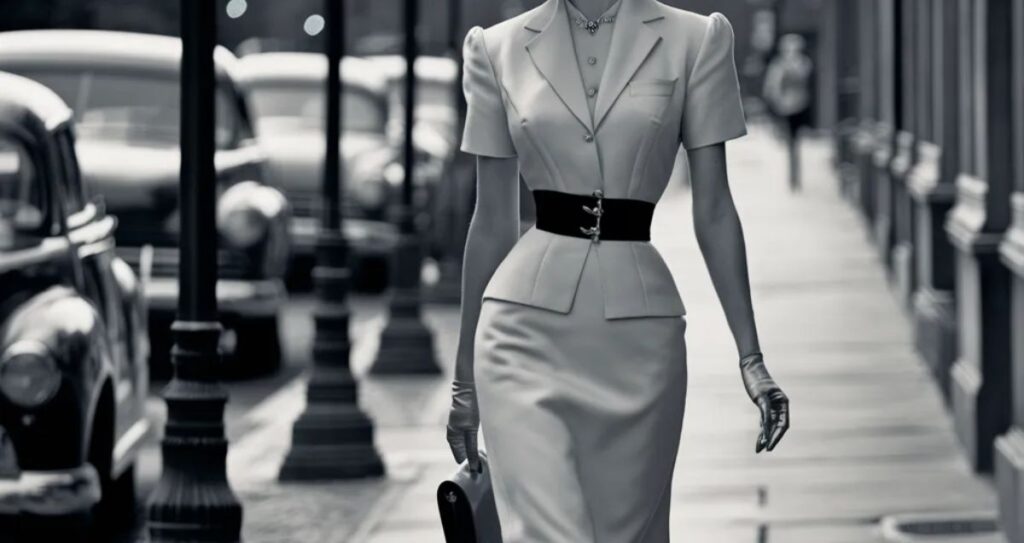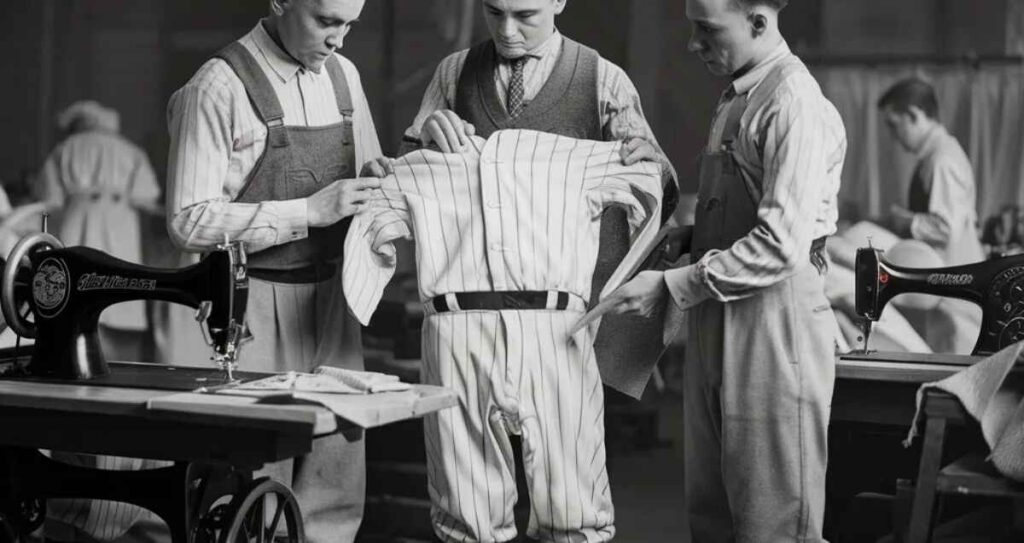Women’s Fashion in the 50s featured elegant, feminine styles. Full skirts, fitted waists, and glamorous dresses were popular, reflecting the era’s emphasis on sophistication and grace. Keywords: women’s fashion in the 50s, elegant styles, full skirts, fitted waists.
The 1950s ushered in a glamorous new era of feminine fashion. From Dior’s revolutionary hourglass shapes to Hollywood’s iconic style influencers, the decade redefined sophisticated elegance.
In this blog, we will discuss these topics iconic elegance: the timeless allure of women’s 1950s fashion, the revolutionary new look that reshaped fashion, mastering the dior silhouette, from paris to Main Street: democratizing the look, the birth of american sportswear, the iconic ivy look for collegiate girls, casual icons: McCardell and khakis.
Iconic Elegance: The Timeless Allure of Women’s 1950s Fashion,

The 1950s ushered in a new era of glamour and femininity in women’s fashion that still captivates and inspires today. After World War II’s hardships and fabric rations, the 1950s represented a Renaissance of sorts – a blossoming of bold creativity, vibrant colors, and hourglass silhouettes that celebrated the female form.
From the game-changing New Look of Christian Dior to the rise of relaxed American sportswear, the decade has welcomed a refreshing spirit of joie de vivre and ladylike elegance.
Hollywood’s biggest starlets became style icons, and their red carpet-looks were eagerly replicated by fashionistas everywhere. It was an age of pure glamour and sophistication that forever imprinted some of fashion’s most memorable and influential trends.
Uncovering The Enduring Appeal Of 1950s Fashion
In this in-depth look at 1950s women’s fashion, we’ll explore the iconic styles that emerged, from the cinched-waist dresses to the full, swishy skirts. We’ll spotlight the pioneering designers, the colorful palettes, and the iconic looks that defined the era.
Whether examining lavish couture or casual sportswear separates, we’ll uncover why this decade’s aesthetic has become a perpetual source of inspiration for generations of fashion lovers.
The Revolutionary New Look That Reshaped Fashion

We were emerging from the period of war, of uniforms, of soldiers. I drew flower-women, soft and rounded, with blossoming busts and handspan waists above enormous skirts.” – Christian Dior
In the gloomy aftermath of WWII, the fashion world desperately needed joy, opulence, and unbridled femininity. Cue Christian Dior and his iconic 1947 “New Look” collection that instantly shook up the status quo and reset mainstream fashion ideals.
Read this article: Men’s Fashion In Spain
After years of fabric rationing and utilitarian styles, Dior audaciously reintroduced a deliciously curvaceous, hourglass silhouette. His glamorous designs made liberal use of rich fabrics like crisp taffeta and drapey wool. Iconic elements included:
- Nipped-in waistlines, emphasizing a teeny 19-inch waistline
- Full, calf or ankle-length skirts supported by crinolines/petticoats
- Sharply tailored jackets with padded shoulders
- Corseted waist cinchers crafting an exaggerated hourglass shape
- Stiletto heels and pointed-toe shoes
Dior’s New Look caused an immediate sensation and backlash, both celebrating and criticizing its overt femininity and impracticality. Critics mocked the excessive skirt volume and impossible-to-maintain waistlines. Nonetheless, it heralded a glamorous new age of extravagant shapes and unabashed luxury.
Mastering The Dior Silhouette
Creating the famed Dior curves and hourglass shape was both an art form and an exercise in restraint and structure. Under a tailored jacket, a woman’s waist was nipped in precariously with a rigid waist cincher. Skirts required incredible excessive flaring and petticoat support to achieve their signature volume.
For a look at just how complex and architectural Dior’s designs were, let’s examine the quintessential pieces:
The Bar Jacket
- Deceptively simple, with a fitted bodice and cropped length
- Intricately tailored and darted to sculpt and enhance the bust line
- Paired with the designer’s slim skirts and cinched at the waistline
The H-Line Dress/Skirt
- A softer take on the New Look’s full skirt volume
- Though still very full, the skirt draped in more fluid lines versus a harsh bell shape
- Typically hit at the calf or ankle in length
The A-Line Dress
- The most figure-flattering and versatile silhouette
- Skirt volume fanned out naturally from the shoulders in an A-shape
- Worked for day or evening in different fabrics and embellishments
While Dior’s look was revolutionary, achieving its dramatic yet refined shapes required masterful construction in patternmaking, darting, and tailoring. The tiniest adjustment in a seam could dramatically impact the final silhouette.
From Paris To Main Street: Democratizing The Look
Also read this article: Black Women’s Fashion In The 70’s
Though corseted and crinolined New Look originated on Parisian runways, more affordable adaptations soon brought the coveted shapes to Main Street, USA. Hollywood costume designers also referenced Dior liberally for starlets’ big-screen looks.
By the 1950s, patterns and home economics classes taught women how to recreate the iconic hourglass lines at home. Well-known brands like Hillary Clothes, Jonathan Logan, and Toni Owen offered more wallet-friendly takes on the Dior aesthetic.
Contemporary advertisements tout “Paris Inspired” or “Designer Style” shirtwaist dresses made of affordable cotton, rayons, and blends. Calf-length circle skirts with petticoats invoked Dior-lite silhouettes for the suburban set. While lacking the exquisite handmade couture details, the mass market embraced the New Look’s signature curves and volume.
The Birth Of American Sportswear

While curvaceous evening and cocktail attire defined the decade’s formalwear trends, the 1950s simultaneously gave rise to much more relaxed and practical American sportswear looks – separates ideal for the modern, active woman.
Pioneering this casual daywear aesthetic were innovative designers like Claire McCardell, Bonnie Cashin, and Joseph Halpert. Their pared-down pieces in sturdy cotton, denim, and knits allowed freedom of movement while still being stylish.
McCardell’s mix-and-match coordinates like slim capris, full skirts, and kitten heels exemplified this relaxed ethos. Her groundbreaking monastic dress with a casual, unfitted shape was considered the original “flat look” in opposition to Dior’s corseted structures.
Other quintessential 1950s sportswear pieces included:
- Pedal pushers: Cropped, calf-length pants
- Bermuda shorts: First highlighted in the British colony, these loose, knee-length shorts were a summer staple
- Knit separates: Shetland sweaters, cardigan sets, and knit dresses in soft wools
- Wraparound styles: House dresses, beach wraps, and peasant tops that easily slip over the body
- Shirtwaist dresses: Button-front dresses with tailored bodices and full skirts – both utilitarian and flattering
While not nearly as structured or fussy as Dior’s New Look, the sportswear trend embodied its own brand of casual glamour. Full skirts and hourglass sweaters provided an athletic yet still womanly silhouette. Tasteful trims like rickrack, eyelet, and grosgrain ribbons added flirty embellishment to simple pieces.
By the late 50s, designers like Rudi Gernreich took these unfitted shapes even further in his basic, minimalist shifts and A-line styles that defied conventional darts and corseting. The nascent youth rebellion was birthing more avant-garde, unstructured looks – a stark contrast to the ladylike formality of the decade’s earlier years.
The Iconic Ivy Look For Collegiate Girls
On college campuses everywhere, the “ivy look” reigned as the signature 1950s sportswear uniform for trendy coeds. With its roots in the prim, buttoned-up style of East Coast prepsters, it evolved into a uniquely youthful and tomboyish aesthetic.
Key components of the ivy look included:
- Oxford cloth button-downs
- Slim-fitting wool or corduroy Bermuda shorts
- Knee-length socks and saddle shoes
- Varsity cardigans, argyle sweaters
- Peter Pan blouse collars
Young girls looked to fashion icons like Grace Kelly and her Hitchcock heroine for how to style the ivy staples in a flatteringly feminine but scholarly way. Chunky pearls, scarves, pleated skirts, and circle pins accessorized the prim collegiate aesthetic.
Casual Icons: McCardell And Khakis
American sportswear originated with the innovative yet humble designs of Claire McCardell, who is credited with first popularizing separates and casual coordinated pieces.
Some of McCardell’s most iconic and influential creations included:
- The monastic dress (an original unfitted smock style)
- Flat-front khaki pants
Conclusion
The 1950s brought glamorous, feminine fashion still influenced today. The decade celebrated ladylike aesthetics from Dior’s New Look to American sportswear after WWII austerity. Style icons like Hepburn, Monroe, and Kelly set trends by blending curves with delicate accents.
1950s fashion’s cinched waists, full skirts, and charming separates proved eternally stylish. Designers reimagined femininity post-1940s utility with a romantic, sophisticated vision of womanly elegance from runways to the mainstream.
Welcome to FashionTrista! I’m David Mark, and I’m excited to share my passion for fashion with you. At FashionTrista, we offer a curated selection of the latest trends, style tips, and fashion advice to keep you ahead of the curve. Whether you’re looking for outfit inspiration or expert guidance, FashionTrista is your go-to resource for all things fashion. Explore with us and redefine your style journey.
